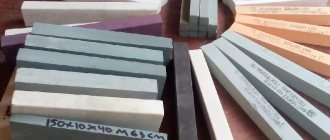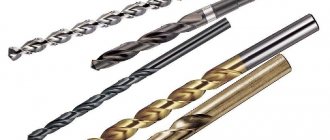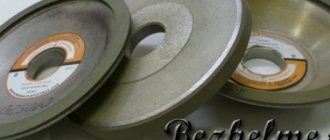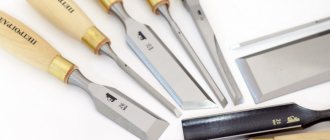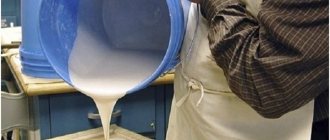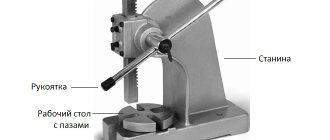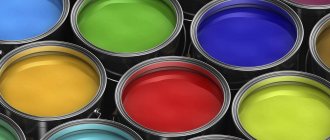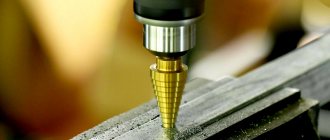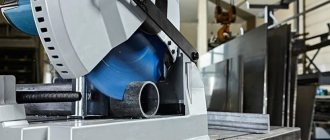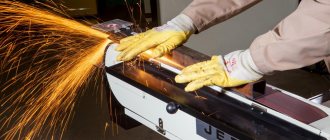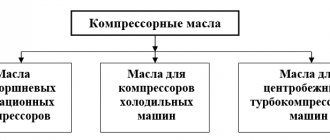A sharpening stone can be synthetic or natural, made of silicon, aluminum oxide, or diamond-coated. There are also water and oil stones for sharpening cutting surfaces.
The most popular manufacturers of whetstones are the USA, Russia, China and Japan. The standard surface grain parameters of a tool in the latter country are recognized throughout the world and are considered an accurate indicator of its effectiveness.
The price of sharpening stones varies - from 116 rubles to infinity. If we take the optimal price-quality ratio of the product, then its cost will be 3-6 thousand rubles.
Sharpening stone: what is it, what does a whetstone mean?
A sharpening stone is a tool that belongs to the category of universal ones and is used for the full maintenance of knives, razors, scissors and other objects with a cutting edge.
They are considered the optimal choice for sharpening because they allow you to independently choose the intensity of processing of the cutting edge and adjust the pressure force - this is the main difference between sharpening stones and machines with high speeds, work on which often leads to damage to cutting tools.
The whetstone can come in different sizes, the smallest are called whetstones.
| Materials for making whetstones | Natural, synthetic |
| Coating grain | Small, medium, large |
| Types of whetstones | Diamond, ceramic, water, abrasive, emery and others |
| Production | Japan, Russia, USA, China |
| Price | From 300 rubles and above |
Grinding stone grit: table
When choosing a sharpening stone, pay attention to its grain size - a parameter that indicates the level of aggressiveness of the impact on the sharpening surface; its characteristics and types are presented in the table.
Too large grains on the surface of the whetstone leave grooves/scratches on the cutting surface; this is unacceptable for some materials and tools. And professionals consider a sharpened surface to be ideal if it is free of burrs and any other defects. Therefore, the coarse grain size of the stone is suitable for rough repair and restoration work.
If you use a sharpening stone with a fine-grained surface, the quality of the work will be very high, but it will take a really long time to get the desired result. Experienced sharpeners recommend having sharpening stones with different grit levels available in order to start the process with rough sharpening and finish with bringing the cutting surface to “ideal”.
Stones from the Small NANIWA Flattening Stone series of various grain sizes
What is grit
Grit, grit is the level of grit of sharpening stones. This technical parameter is indicated in numbers, for example: if we are talking about a stone with a grain size of 120 grit, then it is used for rough sharpening of the cutting surface (coarse grain), finishing the sharpening work with fine grain stones (1200, 3000, 8000 grit).
What is emery
Linguists never tire of arguing about the origin of this word. Some argue that it has Old Russian roots and means a battle ax or a large club. Most likely, others who talk about ancient Turkic word formation are right. From this language, emery has a single and simple interpretation - a stone for grinding. This mineral was indeed mined in Greece and Turkey, but has long been supplanted by new, more technologically advanced abrasives.
But for a “handy” person, as well as for most ordinary people, this term means, first of all, a machine or even a modest machine tool, equipped with an engine and sanding wheels. Sharpening a tool is its main purpose. That's why these devices came to be called sharpeners.
In fact, the scope of application of emery is much wider. With its help, you can cut workpieces when it comes to a thin and extended range of material (wire, fittings, pipe, etc.). Often these machines are used solely for manual grinding or polishing purposes. In general, for removing a layer of material from a workpiece that can be held freely in your hands, sandpaper is the best option. Moreover, they are often used in the process of shaping parts, especially flat ones.
For ideal sharpening of some types of tools, turning cutters, for example, a diamond wheel is installed on the sharpener. But even in this case, the presence of a regular sanding wheel is necessary. With its help, preliminary processing of the cutter is carried out to form the necessary angles and remove burrs. Only the cutting edges on the carbide plate and the groove, if needed, are processed with diamond.
The many applications of the sharpener are made possible by the variety of characteristics of sanding wheels and their electric drives. The latter provide the necessary rotation speed and power sufficient to perform a particular operation.
What types of sharpening stones for knives are there?
Sharpening stones for knives are divided into two main types - natural and synthetic.
| Natural | Synthetic |
| Consist of minerals mined as minerals | Made from heavy-duty materials bonded together at high temperatures during processing |
| Two subspecies are considered popular - Arkansas and Japanese | There are 3 main subtypes - diamond, water and ceramic |
| There are 3 strength classes - soft, medium, hard | Features a long service life |
Water
Sharpening water stones (wet) belong to the category of artificial (synthetic), made from carbide and oxides of silicon, aluminum, and chromium. The production technology of this tool is such that the presence of particles of different sizes in the structure of the stone is not allowed - this negatively affects the results of sharpening cutting devices.
Depending on what binder material is used in production, water stone can have different hardness. For example, if the “bundle” is ceramic, then this indicator will be high, and if bakelite is used, it will be lower.
The peculiarity of a water (wet) whetstone is the need to soak it before starting work. Depending on the grit level of a particular instrument, soaking time can vary from 5 minutes (coarse grain) to 15 minutes (fine grain). You can tell that the tool is ready for use by looking at the air bubbles in the water - as soon as they stop forming, you can start sharpening the cutting surfaces.
Russian water stones Petrograd Water stones RUBANKOV.NET Sharpening water stones GRINDERMAN Chinese water stone
After soaking, the grinding surface is an accumulation of a mass of water, tiny metal particles and abrasive chips. This ensures uniform sharpening of the entire cutting surface.
Emery
Emery whetstones are used for electric machines that are equipped with grinding wheels (“emery pads”). At home, you should use white emery stones - they are durable, suitable for sharpening soft metals, and can be used for straightening knives and scissors. The composition of the material is soft, the temperature when the metal rubs against the stone is low, and the result is a fairly high-quality sharpening of tools.
There are also green sanding stones that are designed for working with hard metals. They have a high friction temperature, so they are not used for sharpening kitchen knives and scissors - scale will instantly appear on the blade, and the cutting surface will be hopelessly damaged.
Green grinding wheel White grinding wheel
Sandstone grits can be 8, 12, 16, 25 and 40, with 8 being the finest surface grit and 40 being the coarsest.
Diamond
Diamond is recognized as the hardest mineral in the world, it is used in the manufacture of sharpening tools with different grain sizes. The working layer of this mineral is made very thin, because the material is too expensive, but this does not affect the service life of the sharpening stones. It is believed that you can use such a sharpening tool for 10 years or more.
Diamond sharpening stones act very aggressively on the cutting surface and, although they allow you to complete the process in a few minutes, they quickly render it unusable and cause breakage of knives and scissors. Experts recommend that beginners limit themselves to medium-grained bars without such coating.
The difference between a diamond sharpening stone is that its surface is not clogged with foreign particles , so after use the tool is simply rinsed with cold water.
Watch the video about budget diamond sharpening stones:
A really high-quality stone of this type is quite expensive, but if you buy cheaper analogues, the surface will wear away very quickly. Accordingly, the service life will be reduced significantly.
Ceramic
The most modern type of abrasive stones is ceramic, in the production of which special materials are used (they are also used for the production of microcircuits). Ceramic can be used directly to make bars for sharpening cutting surfaces or an abrasive surface.
Sharpening tools on ceramics takes a long time and slowly; often such stones have a specific shape, which allows craftsmen to sharpen needles, nail scissors, fishing hooks, and blades. To begin work, ceramic stones are not wetted with water, but must be washed at the end of the process.
Ceramic stone (alumina ceramic) Fine Grit Tojiro F-472 – Ceramic water stone
Natural
The most popular are Arkansas and Japanese. Arkansas stones are a natural combination of quartz and rocks. The materials for its manufacture are mined in America, but their reserves are strictly limited, so the cost of such an instrument is always very high.
The second subtype of natural stone is Japanese waterstone. The material is mined in many regions of the country, but due to restrictions on its extraction, the cost of a sharpening tool will be “obscenely high.”
Professional natural stone Arkansas Translucent 1200 grit Japanese water stone S-3000/1000 on a stand
Oily
Oil sharpening stones are made from durable ceramics and have a longer service life because a more durable binder material is used in production. The peculiarity of oil whetstones is the variety of their shapes, which makes it possible to work with non-standard tools such as “bread” knives and serrated ones.
The surface of the stones has absolutely the same grain size, and this significantly speeds up work on them. There is also a drawback: it is impossible to achieve a “mirror” surface of the blade; it is better to use them at the “grinding” stage, when you need to make the blade thinner or remove small defects from its surface.
Watch the video review of Washita natural oil stone:
Round
Round sharpening stones are used for working on machine tools. They can be made from different materials, but more often they are synthetic - the machine produces too high speeds, so the hardness of the device must be maximum so that the blade or the stone itself does not collapse during operation.
The slipper type of tool is also available in small sizes; it is a cylinder that can be used to sharpen any knives. Manufacturers warn that it is impossible to achieve a perfect result with such stones, but they are effective as a “correction”.
Round whetstone
Marking of grinding wheels
Content
Wheels for sharpening and grinding machines are used for a wide variety of jobs. One removes paint and rust from metal workpieces. Others are needed for sharpening knives, ax blades, saw chains and discs. The third ones carry out finishing treatment of the surface. How to understand the variety of equipment and choose the right one? Let's decipher the symbols and read the markings that the manufacturer places on the packaging or the product itself.
How to decipher the markings of grinding wheels
At first glance, everything is simple. You need to look at the parameters of the equipment, and it will be clear what equipment is suitable for it. The type of work to be done is also taken into account. However, it must be borne in mind that manufacturers use two labeling systems. Some are guided by the Soviet GOST, others by the modern GOST R. We will describe each marking point for grinding wheels separately and indicate how it is designated in different GOSTs.
Circle size
Indicated in the name of the grinding wheel and duplicated on the packaging. For example, in the name of a grinding wheel 175x20x32 mm, the numbers mean the following: 175 mm is the outer diameter, 20 mm is the height of the wheel, 32 mm is the internal landing diameter. The machines are designed to work with circles of certain sizes. These requirements, as a rule, are in the instructions for the equipment, and they must be taken into account first.
Rotational speed
Depends on the strength of the circle. It must withstand the speed that the grinding or sharpening machine will give it. If the equipment is not strong enough, it will wear out quickly, and very soon you will have to buy a new one. Manufacturers indicate on the wheels the maximum permissible rotation speed of the equipment in two units of measurement - m/s and rpm.
How is the speed of rotation indicated in the markings of circles?
Circle shape
Determines the nature of the work that can be performed with this equipment. The knife blades are straightened in a circle with a straight profile. A conical profile wheel is needed for saw chains and discs. There are 14 forms of equipment. According to old standards, the shape of a circle is indicated by letters and numbers; according to modern standards, only numbers. One of the labeling options is most often in the name. Example of numerical marking: grinding wheel 1 – a product that has a straight profile.
Shapes of grinding wheels and their markings
Type of abrasive
Abrasive material is a tiny grain with sharp edges that removes layer by layer from the workpiece. The properties of the particles determine whether the surface will become smooth or rough after treatment. The main qualities of abrasive materials are hardness, resistance to mechanical stress, high temperatures and chemicals.
Types of abrasives, their properties and markings
Each material has subspecies that differ from each other in parameters and manifest themselves differently in operation. For example, normal electrocorundum consists of 93–96% aluminum oxide, and its variety, white electrocorundum, contains up to 98–99% of this substance. Therefore, it is harder and has increased abrasive ability and fragility. Grinding with such equipment is better and there are fewer burns to the metal. This material is designated as 22 A or otherwise - 23A, 24A or 25A. The higher the numerical value, the stronger and better quality the grain.
Marking of abrasives
Grinding wheel grit
Shows the size of abrasives and is measured in microns. The more uniform the particles are in size, the better the surface is processed. There are two systems for marking grinding wheels according to this parameter. The Soviet GOST 3647-80 uses a numerical notation system. The number 1 indicates a grain size of 10 microns. If the wheel grit is 40, then the grain size is 400 microns. The new GOST R 52381-2005 repeats the FEPA marking system adopted throughout the world. In it, grain size is designated by the letter F with a number. The higher the number, the finer the abrasive particles. For example, the marking F70 means that the grain size is 200 - 250 microns, and F40 indicates that the size is 400 - 500 microns.
Typically, the grain size is selected depending on the material being processed, the desired roughness of the workpiece, and the thickness of the layer being removed. For example, first rough grinding is carried out with a wheel with a coarse grain, then finishing is carried out using equipment with a fine grain.
Wheel hardness
Indicates the ability of the bond to resist chipping of grains and indicates the wear resistance of the equipment. The grain must completely exhaust its resource and only then fall out of the bundle, revealing the next layer of abrasive.
The degree of hardness in the markings of grinding wheels
The most common wheels are medium hard. But still, the choice depends on the task ahead: what equipment and what material will be processed. An error in selection will affect the quality of work. Insufficiently hard equipment will quickly exhaust its service life. If the hardness is too high, cracks or burns will appear on the treated surface.
Grinding Wheel Structure
Shows the mixing proportions of abrasive and binder. The more grains, the higher the density. The larger the bond, the more space between the abrasive crystals and the more porous the wheel structure will be.
Types of circle structure in markings
The choice of equipment for this parameter depends on the material to be processed. Equipment with a dense structure is used to grind hard materials and carry out abrasive trimming. Non-ferrous metals and alloys with high viscosity are processed using wheels with a highly porous structure.
Type of bundle
The bond can be bakelite, ceramic and vulcanite. The composition of the binder affects the characteristics and scope of application of grinding equipment.
Types and properties of ligaments
Designation of the bond in the marking of grinding wheels
Accuracy class
Shows the degree of compliance of the equipment with the declared geometric shape and dimensions. Here the uniformity of abrasive grains, their grade and the balance of the working surface are assessed. There are three accuracy classes, which are indicated in the markings of grinding wheels.
Stones for sharpening knives: the best by manufacturer
The best manufacturers of stones for sharpening knives are considered to be Russia, Japan, China and the USA; Soviet-made tools can still be found on sale, and many professionals prefer them.
Russian made: Petrograd, Grinderman, Gritalon
Sharpening stones, which are produced in Russia, are distinguished by the correct price-quality ratio.
Of the most popular, it is worth highlighting:
| Name | Description | Photo |
| "Petrograd" | This brand produces silicon carbide stones that are distinguished by a variety of surface hardness. It is important that the degree of graining exactly corresponds to Japanese standards - they are recognized throughout the world as the best. | |
| "Grinderman" | The production is located in St. Petersburg, the company not only produces various sharpening tools, but also provides full service. | |
| "Gritalon" | They produce synthetic abrasive tools that can be used both for sharpening machines and for manual work. The material used in production is silicon carbide. |
Japanese: Suehiro, YOSHIKIN, Yaxell, Samura
Sharpening stones made in Japan are usually used for manual work and with water; the most famous brands of such tools are:
- Suehiro;
- Yoshikin;
- Yaxell;
- Samura
The difference between such stones is that when sharpening cutting surfaces, new layers of abrasive are constantly “opened”, and particles of the previous ones are mixed with water and have the best possible effect on the blade.
Sharpening stone Samura Sharpening stone Yaxell Sharpening stone Global MinoSharp from the manufacturer Yoshikin Sharpening water stone Suehiro
The Japanese produce sharpening stones with different degrees of grain, so when using a tool with fine grains at the last stage, it makes it possible to bring the cutting surface to perfect condition without the additional use of pastes, felt and dressing slings.
Japanese water stones are distinguished by the highest productivity, which can only be compared with diamond tools. But the latter increases the risk of excessive thinning of the blade at the final stage of finishing the cutting surface.
Japanese whetstone grit standards are recognized by international organizations and are used for designation by most manufacturers.
Soviet
Soviet sharpening stones are bars of absolutely regular shape, onto which a coating of abrasive material (base – silicon) was applied. You can still find Soviet sharpening stones and whetstones on sale at flea markets - they are considered high quality and “eternal.”
On the territory of the USSR, they used their own, individual markings, which are radically different from modern ones.
What was indicated on each product:
- dimensions;
- accuracy class;
- manufacturer (each had its own mark);
- dimensions;
- hardness level;
- structure characteristics;
- product type;
- material used in manufacturing;
- grain level.
Microcorundum block for straightening USSR razors, 1970
Chinese: Ganzo
Chinese sharpening tools include silicon carbide and aluminum oxide stones, which are characterized by fairly high quality, long service life and low cost. The most famous manufacturer is Ganzo. Such tools are especially good for sharpening ordinary kitchen knives - their grit level does not exceed 1000 grit, which allows you to bring the blade to the desired sharpness with one whetstone.
Recently, sharpening stones from China made of vacuum ceramics and boron carbide have appeared on the market. They have an almost eternal service life; even with prolonged sharpening of the tool, they do not wear out.
Chinese sharpening tool Ganzo
Arkansas: Dan's, Smith's, Lansky
Three companies stand out from the manufacturers:
- Dan's;
- Smith's;
- Lansky
Arkansas is a state in America where abrasive material is mined and grindstones are produced. Mineral reserves in this part of the country are already greatly depleted, so the cost of the tool is very high even by the standards of the Americans themselves. However, Arkansas stones have always been popular and are now considered the best quality on the market.
Lansky whetstone Smith's whetstone Dan's whetstone
2 Device for sharpening turning tools
Sharpening tools involves not only wheels, but also the use of additional devices - boring machines.
Jig boring machines bore, drill, countersink, cut internal and external threads, grind cylindrical surfaces and trim ends.
Tool sharpening machine
A distinctive feature of the machines is a horizontal (or vertical) spindle, which makes axial feed movements. The necessary tool is fixed into the spindle hole - a boring bar with a cutter, a reamer, a drill, a milling cutter, etc.
- horizontal boring;
- coordinate boring;
- diamond boring;
- vertical boring.
Specialized models of jig boring machines:
- Jig boring machine 2D450.
- Jig boring machine 2V440A.
- Jig boring machine 2431.
- Jig boring machine 2421.
2.1 Sharpening technology
- Main back surface.
- Auxiliary back surface.
- Front surface.
- The radius of curvature of the ring.
At the end, the sharpening angles are checked using a template.
Types of sharpening of cutters
To obtain an even and smooth edge, the tool must be constantly in motion along the grinding surface. With this kind of work, the circles will last longer.
The tool can be processed dry or with water. The flow of water must be sufficient and continuous. A dry tool should not be immersed in water, as this may cause destruction of the working edge.
- fine-grained whetstone (technical oil is also used);
- copper wheel (boron carbide paste and technical oil are also used).
Finishing can only be done on cutting tools (edge width up to 3mm).
2.2 Safety precautions
- Do not use grinding wheels whose operation is accompanied by beating.
- The tool rest should be securely fixed closer to the circle.
- Use a tool rest to support the cutter.
- Do not press the cutter too hard (uneven heating can cause cracks; under high pressure the wheel can quickly deteriorate).
- Do not sharpen without a protective guard.
- Wear safety glasses.
- The workplace must have local ventilation.
Sharpening stones for machine tools
Sharpening stones for machine tools vary in shape and composition. They can be used for sharpening not only cutting tools, but also any other metal products. Most often you can find a stone made of silicon carbide, but the most durable is considered to be CBN - an abrasive material based on boron nitride, which makes the tool as durable as possible.
All sharpening stone attachments for machines are divided into two types: black – the most resistant/strong and green. The first is used for rough sharpening of the cutting surface, while green is used to bring it to the desired state.
Sharpening machine 150 mm Titan BNS25-150
Grinding wheel sizes
For cleaning and polishing parts made of different materials, grinding wheels are used, used on machine tools, grinders, and emery sanders.
Parameters of standard grinding wheels:
- Outer diameter: 16 (mm), 20 (mm), 25 (mm), 32 (mm), 40 (mm), 63 (mm), 80 (mm), 125 (mm), 200 (mm), 350 ( mm), 600 (mm), 1060 (mm).
- Disc thickness: 3.2 (mm), 6 (mm), 12 (mm), 25 (mm), 40 (mm), 63 (mm), 80 (mm), 100 (mm), 150 (mm), 160 ( mm), 200 (mm).
- Inner diameter: 1.6 (mm), 4 (mm), 8 (mm), 10 (mm), 16 (mm), 32 (mm), 51 (mm), 76 (mm), 127 (mm), 203 ( mm), 305 (mm).
Grinding wheel markings:
The marking of the wheels indicates: abrasive, most often it is electrocorundum (12A, 14A, 16A, 22A, 24A, 33A, 37A, 38A) the higher the number, the higher the quality, or silicon carbide (52C, 54C, 55C, 62C, 63C, 64C) black or green.
The grain size ranges from F4 to F2000 (the larger the number next to F, the finer the grain).
The hardness of a circle is divided into 8 groups and designated in Latin letters (from F to Z) depending on its degree.
The structure of the tool is the ratio of abrasive material to the volume of the tool and is indicated by a number from 1 to 12.
Accuracy classes are divided into 3 types according to deviation measures: AA from 0.3 (mm) to 3 (mm), A and B from 0.4 (mm) to 6 (mm).
So a standard circle will be marked 150x16x32 25A 46F L 6 B.
Important: damage to the edges (up to 5 mm for class B), foreign inclusions (0.5 (mm) for AA, 1 (mm) for A, 2 (mm) for B) are not allowed on the wheels.
Source: razmery.info
Which sharpening stone to choose for kitchen knives
For kitchen knives, it is better to choose a water sharpening stone - they “work” faster and allow you to straighten the cutting surface without changing tools until you get the desired result. But you need to remember that some knife materials can rust when in contact with water, which will hopelessly ruin your kitchen tool. In this case, it is better to use oil sharpening stones - sharpening takes a long time, but it is always of high quality, and the blade of the knives does not rust.
As for the grit level of the whetstone, 1500 grit is sufficient for kitchen knives, because 240 grit is too coarse an abrasive surface that greatly thins the knife blade.
Green structural elements
However, tools made of non-hard grades of steel are not always used in production and even in everyday life. If we take, as an option, drilling systems, and even the same hammer drills, then an ordinary electrocorundum emery wheel will not be able to effectively cope with sharpening the drill. In this case, manufacturers offer so-called “green” sandpaper mugs. They are named so, naturally, because of their color.
The important aspect is that this type of equipment cannot be used when working with, say, scissors or standard kitchen knives. Upon contact, a very high temperature appears, which leads to instant overheating of the steel and the tool losing its cutting properties. Simply, you can throw it away. It is for this reason that it is not recommended to use a green emery wheel in everyday life. And its cost is disproportionately higher than white.
If we talk about geometric dimensions, they can be exactly the same as those of the electrocorundum analogue. But they can also significantly exceed them, since the main task is to ensure a complex technological process in production, where heavy equipment and machines are used. As a result, for example, the mounting holes can be 76 mm, 127 mm, or even 203 mm.
What parameters need to be considered when choosing an emery wheel?
- External diameter. And here the principle, the more the better, does not work.
- Equipment power. On more powerful machines, consumables can be installed with greater grain size and abrasion resistance.
- Bore hole diameter. Many inexperienced specialists simply forget about this indicator.
- Grit, which, as noted, determines the accuracy of sharpening the tool.
- And an important aspect is the manufacturer. Naturally, it is best to purchase products from well-known brands.
Thus, if you approach the issue of choosing an abrasive as responsibly as possible, and even better, consult with professionals, then the product will last a long time and effectively, paying for itself many times over.
Source: abraflex.ru
How to choose a sharpening stone for tools
The selection of a whetstone should be made taking into account the following parameters:
- Abrasive grain size . It can be small, medium and large. The latter is necessary to eliminate chips on the surface of the cutting tool, because only coarse grain size can remove layers of damaged metal.
- Material of manufacture . In terms of characteristics and service life, synthetic sharpening stones are many times superior to natural ones, but this ratio is appropriate to take into account only when choosing a device from the middle price category. If you are planning to purchase a high-quality sharpening stone, then you should pay attention to Japanese manufacturers.
- Dimensions . If a stone is purchased for sharpening kitchen knives, then the shape and size practically do not matter. But if you constantly use a sharpening device on hikes, at work you should choose small sizes, even pocket-sized options.
What grit to choose for sharpening a knife
The grain size for sharpening a knife should be selected depending on the goals pursued; experts say that you need to have at least 3 stones in your arsenal:
- 120 grit – for rough metal processing;
- 1000 grit – to level the surface;
- 2000 grit – for straightening the blade.
But practitioners believe that knives can be sharpened with a stone with a grain size of 1500 grit. Such kitchen tools come straight from the store sharpened and only need to be slightly adjusted during use.
Characteristics of sanding wheels
The classification of emery wheels is based on their geometric shape. Based on this feature, products can be cylindrical (CC) and conical (CC) cups, disc-shaped (T) disks and others. In everyday life, a flat disk shape with a straight profile (PP) is most often used. Abrasives with a double-sided conical profile (2P) are less relevant in the home workshop, but they are still in demand for sharpening the teeth of saws and other tools.
The next most important parameter of an abrasive disc is its geometric dimensions. It includes diameter, thickness and fit. The latter indicates the size of the mounting hole in the product and in most cases is equal to 32 mm. Exotic abrasives with mounting diameters of less than 10 mm, used for machinist finishing of precision parts, as well as discs with a 76 mm mounting, used for cylindrical and flat grinding, are typical for industry and are difficult to adapt to economic needs. Therefore they are not considered here.
For the same reason, this publication does not focus on discs whose width is not included in the range of 10, 16, 20 and 25 mm. These sizes are optimal for use in private households.
How to make a whetstone with your own hands
You can make your own whetstone from ceramic tiles or silicon carbide and epoxy glue, but first you need to prepare a template and then follow the instructions.
From ceramic tiles
You need to take a fragment of ceramic tile measuring 30x8 cm; if there are mortar residues on the back side, then they must be removed. The relief side of the ceramic tile is ground down on a grinding wheel or sand-lime brick by active friction. During this process, fine abrasive dust will be formed - it must be removed periodically. You can bring the surface completely smooth with regular sandpaper.
As soon as the back side of the ceramic tile becomes smooth, the remaining abrasive particles are removed/washed off and completely dried. The whetstone is ready, you can use it to sharpen your kitchen knives, but you will definitely have to sharpen them until they are impeccably sharp and smooth.
Watch the video on how to make a whetstone for finishing a knife from ceramic tiles:
Made of silicon carbide powder and epoxy glue
You need to purchase 100 g of silicon carbide powder, prepare a wooden board with cuts on one side to fix the abrasive bar, and epoxy glue. For ease of work, you should wear medical gloves and use syringes.
Execution order:
- Mix 6 cubes of resin and 1.2 ml of glue (epoxy glue preparation kit) in a bowl.
- Mix thoroughly and add a little abrasive powder.
- Stir again and add silicon carbide powder again - this must be done until the dry material runs out.
Next, you need to prepare a cardboard box of the desired shape (a rectangular or square block is needed) and pour the prepared adhesive mixture into it. Cover the top with a board, sawn side down, and press down with a weight.
Cardboard boxes of the desired shape
After 3-4 days, the glue will completely harden - and the block is ready for use. You will need to clean its edges and trim it with a file. To make the surface abrasive, you need to drop water on it and rub the frozen surface with a piece of glass with a small amount of sand.
Homemade sharpening stone for knives is ready
Such homemade sharpening stones do not have a long service life, but can be useful in force majeure circumstances.
Stone for dressing water stones
When using water stones, irregularities form on their surface, which impairs the quality of sharpening knives and other cutting tools; you can correct them:
- sandpaper;
- silicon carbide powder;
- sand;
- diamond block.
But it is easier and faster to sharpen the sharpening tool with special stones - synthetic water stones with diagonal cuts along the surface of the same depth. They can be hand-held or tabletop. In the first case, straightening is carried out with a stone with cuts, in the second, the damaged whetstone is ground/straightened on a fixed one.
The most popular stones for dressing water stones:
| Name | Description | Photo |
| Table stone from the Large series NANIWA Flattening Stone for Sharpening Stones (Truing Stone) | It has the same grain size (24 grit) and is made of silicon carbide. | |
| Table stones from the JUUMA Flattening Stones series | Made from aluminum oxide, they are a series of four stones of different grain sizes. It is noteworthy that they are able to rule even each other. | |
| Suehiro Hand Stones | They have a medium grain size (200 grit), are intended for straightening synthetic water stones, correcting both subtle unevenness and deep “pits” and grooves. |
Stones for knife
Ceramic and diamond stones are used for knife blades in the kitchen. They are characterized by fine grain and therefore cannot sharpen the cutting surface efficiently - usually such kitchen devices are used for quickly straightening the blade.
The service life of such blades is short, the abrasive coating on them is thin. Some manufacturers produce a device with three stones - coarse, medium and fine, which makes it possible to increase the level of sharpening of kitchen knives.
How much does a whetstone cost?
A whetstone can cost 116 rubles or several thousand - it all depends on several parameters:
- material of manufacture;
- manufacturer;
- surface graininess.
The average price of a whetstone, where the price/quality ratio can be called optimal, is 3-6 thousand rubles.
